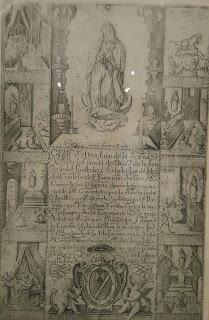The National
Museum of the Viceroy Period (Museo Nacional del Virreinato) in Tepotzotlán, just a 30 minute drive
north from Mexico City, has the largest storage of religious paintings from the
period of New Spain.
Entrance to cloister
orange tree courtyard
Archway courtyard is the
site of exhibit
"Adoration of the Magi"
anonymous Flemish painter
In the first part of the exhibit, we see
samples of Martin de Vos, a Flemish painter
who probably never came to New Spain, but several of his masterpieces arrived
here during the 16th Century.

"Saint John writing the
Apocalypses" Martin de Vos
The exhibit shows us the influence of
the paintings of Pieter Brueghel the Younger, Jan Brueghel the
Younger, Jan Brueghel the Older
and Hendrick Clerck in the Spiritual
and Cultural life of New Spain.
"Crucifixion" Pieter Brueghel the younger
"The Temptation of Adam" Jan Brueghel the
younger
"Expulsion from Paradise" Jan Brueghel the
younger
Yet none of them left such an important legacy
as that of Simon Pereyns, who work not only came to form part of the embryonic
cultural scene of New Spain, but he came here and painted here. The great contribution
of Flanders to art from the 15th Century is its use of oil in
painting.
The Flemish influence in New Spain was not limited to painting, we
see how Samuel Stradanus’ engravings
of the Virgin of Guadalupe became popular in New Spain.
Metal engraving of Our Lady
of Guadalupe by Samuel
Stradanus
Chistophorus Platinus, printed beautifully illustrated Bibles in Antwerp
that came itto New Spain and became the treasures of many of its most important
Cathedrals and Monasteries
Paintings, tapestries, books followed a
route from the shops of Antwerp, Flanders to Seville, Spain. Seville, Spain to
Veracruz, New Spain. Veracruz to Mexico City.
"King David with Bathsheba"
Flemish Tapestry, Silk and wool fibers.
"Adoration of the Magi" Jose Juarez
"Imposition of the chasuble on
Saint Idlephonsus" Luis Juarez
"Saint Augustine writing in the
heart of Saint Theresa"
Juan Correa
"Saint Joachim's Annunciation
by the Angel" Juan Sanchez
Salmeron
"Expulsion from Paradise"
Juan Correa
"Coronation of the Virgin"
Juan Correa
"Conversion of Saint Mary Magdalene"
Juan Correa
"Saint Anthony of Padua"
Antonio Rodriguez
"Saint John the Baptist" Baltasar de Echave Ibia
"Annunciation" Juan Rodriguez Juarez
Another
motif in Flemish painting was the style by which the subject matter was
surrounded by a garland of flowers, and as Juan Rodriguez Juarez and Cristobal Villalpando shows us below, some New Spanish painters took up on this trend.
"Adoration of the Magi"
Juan Rodriguez Juarez
"Virgin and Child"
Cristobal de Villalpando
An important trend in the 15th and 16th century in European Art, particularly during the Renaissance, was the rediscovery of the Ancient World of Greece and Rome and its mythology, a trend that did not take muck root in New Spain.
In the Sistine Chapels in Rome, we find a series of sibyls: the Persian Sibyl, the Erythraean Sibyl, the Delphic Sibyl, the Cumaeaen Sibyl and the Libyan Sibyl.
Michelangelo painted these Sibyls side-by-side with the most important prophets of the Old Testament, as a sign that Jesus Christ was not sent only to the Jewish people, but to mankind as a whole, and that His Salvation was prophesized by the sibyls in different lands and cultures.
From the point of view of Museology, this exhibit offers us a novelty: a series of moving magnifying glasses, by which the visitor can take a much closer look at some of the paintings and tapestries.
The Cumaean Sybil
The Cumaean Sibyl
The Delphic Sibyl
A
collection of six portraits painted by anonymous artists in New Spain
gives us in this exhibit an unique attempt to convey this belief that the coming of Christ and His Salvation was announced to the Sibyls of the Ancient World.
The Samian Sibyl
The
sibyls were incoherent speakers or soothsayers that uttered sentences that in
the context of that moment did not make sense, but were respected and
reverenced.
The Hellespontine Sibyl
From the point of view of Museology, this exhibit offers us a novelty: a series of moving magnifying glasses, by which the visitor can take a much closer look at some of the paintings and tapestries.
Magnifying glass lets us examine the
details of the wool and silk stole.
Magnifying glass shows
details of the robe of
Saint Blandina
The magnifying glass
shows the degree of
detail in the mastery of
the painter hitherto
unknown.
Nothing better to start 2017, than to
see these great baroque painters of New Spain all together in one exhibit. Museo Nacional del Virreinato. Open Tuesday to Sunday, 9:00am to 6:00pm, up until February 26th. So don’t miss
it!































No comments:
Post a Comment